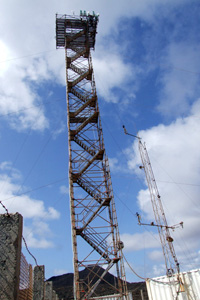RHaMBLe Project-Cape Verde
WP 1 Enhanced long-term characterisation and supplementary intensive detailed study of remote MBL halogen chemistryAims
To provide a detailed characterisation of reactive halogen cycling in the tropical marine boundary layer and their impact on marine oxidation through in situ intensive measurements of all major participating species and to provide enhanced long-term capability for RHS measurement.
Rationale
Few RHS measurements exist in the remote marine atmosphere (Allan et al., 2000, 2001, Saiz-Lopez et al., 2004) and no long-term measurements of RHS have been made at a single location in this environment and variability in RHS is highly uncertain. A fully instrumented project supplementing measurements from the UK SOLAS long-term monitoring station (Sao Vicente, Cape Verde Islands) will determine their variability over an annual cycle, enable direct estimation of the roles of oceanic halogen emissions in MBL chemistry and a detailed prediction of IO, BrO, OH, HO2 and NO3 for comparison with measurements and estimation of the effects of halogens on the sulphur cycle through gaseous oxidation of DMS by BrO (and if the separate Keene / Pszenny proposal is successful, see below, through aqueous oxidation of SO2 by HOX). This will provide confidence in lifetime predictions of trace gases, including reduced sulphur species and greenhouse gases, and in the MBL O3 budget. In addition to a wide range of gaseous species, a characterisation of the available aerosol distribution is available; both to describe the medium for halogen activation and for quantifying the potential sink for radical species, which is thought to play an important role (Haggerstone et al., 2004) in the radical budget.
Description
Long-term RHS measurements; late summer 2006 for approximately one year. Intensive study; summer 2007, 6 week duration. Long-term instrumentation at the Cape Verde site will include a 20 m tower with meteorological and radiometric data, radiosonde launches, gas-phase trace species (O3, NOx, CO, halocarbons, DMS, oVOCs, VOCs and CH4), aerosol size distribution measurements by mobility and optical instrumentation from 10 nm to 30 ?m diameter, major ion composition, OC / EC and total mass by impactor sampling. A long-path broadband differential optical absorption spectrometer (DOAS) (Saiz-Lopez et al., 2004) instrument will be deployed in the same container as the funded GC/MS halocarbon instrument. With detection limits for BrO (0.9 ppt), IO (0.5 ppt), I2 (5 ppt) and OIO (2 ppt) for a light-path of ~8 km and an averaging time of 20 minutes, the instrument will provide a continuous long-term dataset of halogen radical measurements. For the summer intensive project, a laser-induced fluorescence (FAGE) instrument will be used to provide in situ IO, OH and HO2 measurements. Pending independent funding from the US National Science Foundation, research groups led by Professors W. Keene at the University of Virginia and A. Pszenny at the University of New Hampshire will quantify a complimentary suite of constituents including reactive Cl gases; volatile acids and NH3; and size-resolved particulate halogens, I speciation, pH, and Al (see letter of intent).
Delivers
Intensive characterisation of concentrations of trace molecules, radicals and aerosols and extended time series of halogen oxide measurements.
